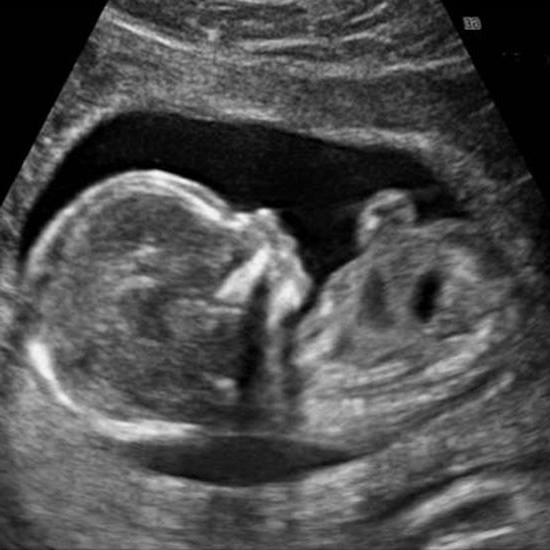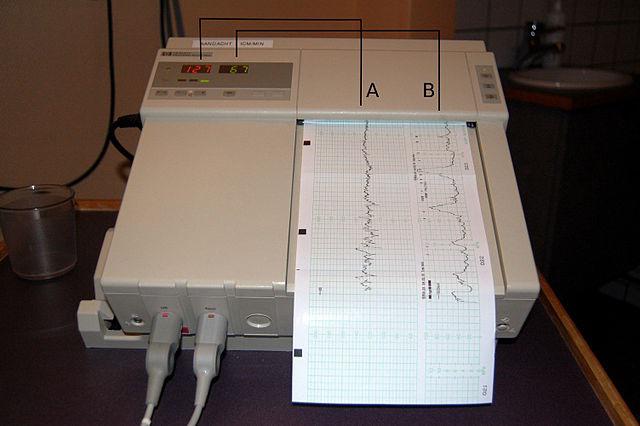When a representative of the fairer sex receives a positive pregnancy test, she has a number of questions and doubts. So, a woman thinks about how quickly her tummy will grow. The expectant mother is interested in her own well-being. Another important issue that worries a woman is determining the sex of her unborn baby. Will it be a boy or a girl? This article will tell you how to determine sex using the fetal heartbeat. You will learn the peculiarities of the rhythm of muscle contractions in boys and girls. It is also worth saying that the sex of the child is determined more accurately by the heartbeat at 12 weeks than earlier or later.
Gender of the child: general description of formation
At the moment of fertilization of the egg, only one sperm penetrates into its cavity. It can carry sex gametes with an X or Y chromosome. Accordingly, the gender of the future baby is determined already at this moment. During this period, the embryo has not yet fully formed, and you will not be able to determine its gender.
At approximately 8 weeks of pregnancy, reproductive organs begin to form. Girls and boys look the same at this moment. However, in the future there will be a major transformation and completely distinct genitals will appear.

Determining the sex of a child by heartbeat in the womb
To begin with, it’s worth saying what meanings exist and how this affects the baby’s gender.
Contraction frequency. It is generally accepted that boys' hearts beat about 140 times per minute. Girls have more frequent contractions. So, the muscle of the future baby can make from 140 to 160 beats per minute.
Rhythm of contractions. The boys can boast of a measured and clear rhythm. Their heart beats smoothly and evenly. In future girls, the muscle contracts chaotically and excitedly. It seems that girls are more emotional individuals even in the womb.
Dependence on maternal pulse. There is an opinion that a boy’s heart beats not only clearly and monotonously, but also much louder. Also, all contractions coincide with the maternal pulse. Girls have no dependence on the beat of their mother’s heart. The tones of muscle contractions of future daughters are more muffled and not as clear.
Belly side. There is a version that the boy’s heart beats on the left. If the sound comes from the right, then most likely a girl will be born.

Fetal heartbeat and gender: what is the connection?
Doctors often listen to the baby's heart rate while monitoring a woman. This is necessary to determine the presence of pathologies. Many parents believe that determining the sex of a child by heartbeat is quite simple and easy. But there are some nuances here: gestational age, features of embryo development.

The first beats of a small heart
In medical practice, it is customary to check the heart rate to monitor the vital activity of the fetus. This is relevant for those women who are at risk. Experts do not use this method when determining the sex of an unborn baby. There are many factors that influence the functioning of a small organism in the womb.
It is important to know! Regardless of whether the woman has a boy or a girl, the baby’s heartbeat starts already from the 3rd week of development. However, you won't be able to listen to it. This can be done around the 6th week. In this case, the baby’s pulse should coincide with the mother’s.
Features of listening to the fetal heart rate by a doctor
Determining the sex of a child at 12 weeks by heartbeat is a difficult task, it is still unstable. To listen to the work of an organ, you can use the following diagnostic methods:
- Auscultation using a wooden stethoscope. It is a small tube with an extension at the end. The doctor simply places the instrument on the pregnant woman’s belly and listens to the heart. This procedure is effective from 18-20 weeks. This method provides accurate information.
- Cardiography. In order to get results, you need to carry out diagnostics for an hour. The woman lies on her side or back. Such a study is most often prescribed from 32 weeks.
- Fetal Doppler. This method allows you to find out the number of heart contractions using a sound wave. The test can be used in early pregnancy.
- 3D research. It allows you not only to hear the sound of the organ, but also to visualize it in great detail. Diagnostics of this type are innovative and can be carried out in the early stages of a child’s development.
The standard diagnostic method is ultrasound. It allows you to calculate your heart rate as early as 8 weeks after conception. However, this requires a doctor's testimony. The first date of ultrasound examination is scheduled for the 3rd month. If the expectant mother is already in her second or third trimester, then the procedure is carried out to determine the location of the organ, the frequency and nature of its contractions.
Fetal heart rate parameters at different stages of pregnancy
The frequency of heartbeats of the unborn child, as well as their number per minute, is not the same at different stages of pregnancy. The average indicators can be seen in the following table:
| Duration (weeks) | Norm (beats per minute) |
| 6 | 104-127 |
| 7 | 127-149 |
| 8 | 149-173 |
| 9 | 154-194 |
| 10 | 160-178 |
| 11 | 154-176 |
| 12 | 150-174 |
| 13 | 147-171 |
| 14 | 146-168 |
| 20 | 140-170 |
| 21-40 | 140-160 |
Such indicators are average, since each small organism has its own developmental characteristics.
Fetal heart rate differences
When determining the fetal heart rate, a boy or a girl is characterized by slight differences; other features must be taken into account. To do this, consider the following table:
| Parameter | Male | Female |
| Heart rate | 120-140 beats per minute | More than 140 beats/min |
| Heart rhythm | Smooth, smooth rhythmic | Chaotic and agitated He is quieter in girls |
| Organ location | Bugged on the left | The knock is detected more on the right side |
| Connection with mom's pulse | It feels clear and smooth | In a baby, this indicator does not depend on the mother’s |
| Mother and son have the same rhythms |
Attention! Recognizing the sex of a child by heart rate is not easy. There are various obstacles that affect this indicator. The reliability percentage is only 3-4%
The essence of the method
It is better to find out whether a woman is having a boy or a girl in a hospital setting using professional diagnostic techniques. For fun, you can try to calculate the number of heart beats per minute.
The procedure involves listening to the organ work for 1 minute. At this time, the number of beats must be counted. A boy's heart rate is lower, and a girl's is higher. A standard medical stethoscope can be used for determination. But it should be used correctly. It is also important to choose a quality tool.
To calculate the floor, you need to carefully look at the table. If the procedure is carried out at 12 weeks, then the average values are 150-172 beats per minute. The smaller number must be subtracted from the larger number and the difference divided in half. The result obtained is added to the minimum number (150). If the heartbeat is higher than this indicator, then most likely the woman will give birth to a girl, if lower - a boy.
Believe it or not?
Each parent decides for himself how reliable this calculation is. User reviews are different. Someone believes it, because he managed to guess the result, while others consider this method of determining gender to be comic. Doctors don't take him seriously either. The fact is that the baby’s heartbeat in the womb stabilizes closer to the 20th week of pregnancy.
There is no statistical evidence for the plausibility of such a study. The fetal heartbeat does not depend on its gender. It is influenced by other factors:
- gestational age;
- hormonal changes in the female body;
- individual characteristics of conductivity and innervation of the myocardium;
- uterine tone;
- the degree of development of the organ or the presence of defects in its formation;
- the presence of pathological conditions in the mother or fetus;
- time of day (the child is also awake and resting);
- woman's blood pressure level.
The baby's activity also affects the heart rate.
How can you calculate your heart rate?
So, you already know how to determine the sex of a child by heartbeat. The options proposed above can be grouped and combined with each other. However, to draw any conclusion, you must first calculate the baby's heart rate in the womb. This manipulation can be carried out in several ways:
- using a stethoscope (this option is suitable for measurements after 12 weeks of pregnancy, when the reproductive organ leaves the pelvis);
- using a tube (this method is used after 20 weeks of pregnancy, when the fetus is already quite large);
- cardiotocography apparatus (research and measurements are made after 30 weeks of pregnancy);
- using Doppler (the device is used after 15 weeks of child development and looks like a miniature ultrasound machine);
- during an ultrasound (diagnosis can be carried out in the earliest stages of pregnancy).
Reliability of the method
How reliably can you calculate the sex of a baby from a heartbeat at 12 weeks? Reviews from those who have already carried out such “fortune telling” indicate that you can trust the method by 70 percent. As we have already found out, the characteristics of the heart rate depend on a large number of factors.
Modern medicine still prefers to determine the gender of the fetus by ultrasound. Moreover, it is best to conduct such a study when the genital organs are already formed. But even in this case, the probability of error is 3–4%.

How to determine the gender of a baby at 12 weeks?
If you want to find out the sex of the baby by heartbeat at 12 weeks, then you need to do an ultrasound examination. During diagnostics, the specialist can turn on the sound of the device. This will allow you not only to calculate the number of contractions, but also to hear them.
The doctor can also display a curved line of the cardiogram on the screen. A special program measures and counts heartbeats. The operation of the technique allows us to avoid errors that could occur when counting blows by a person. So, how to determine the gender of the baby by heartbeat at 12 weeks?
What is typical for girls? During this period, the frequency of muscle contractions ranges from 150 to 170 beats per minute. The knocks are quick and muffled. The rhythm is chaotic and you have a hard time catching the monotony. Also, an experienced specialist may have his own ways of determining the sex of the baby by the sound of his heart.
What is typical for boys? The heartbeat is observed from 120 to 140 times per minute. The sound produced is clear and loud. The contractions are more like the beating of an adult human heart. A special rhythm is also determined. When the blood pressure rises or the mother becomes agitated, the baby’s heart begins to beat faster. This pattern is present in most cases.

Fetal heart rate table by week
The fetal heartbeat during pregnancy is checked for every woman registered. This indicator allows you to:
- confirm the fact of pregnancy. After the first delay, the woman is sent for diagnostics. According to ultrasound, from the 3rd week you can hear the heartbeat. If fetal cardiac activity is not observed, an ultrasound scan is performed again after some time. The absence of a heartbeat indicates a frozen pregnancy;
- assess the condition of the fetus. The child's heart is sensitive to changes. Stress, maternal illness, the amount of oxygen in the surrounding space, sleep and rest phases are immediately reflected in the heart rate. If the heart beats too fast for a long time, the blood supply to the fetus is disrupted. If it is slow, this indicates a deterioration in the baby’s condition. Correction methods largely depend on the period at which the heartbeat became pathological;
- monitoring the condition of the fetus during labor. During the birth process, the baby experiences severe stress and lack of oxygen. Heart rate monitoring allows you to identify difficulties such as umbilical cord compression, placental abruption, and take emergency steps to eliminate the consequences. During labor, the baby's heart rate is checked after each contraction.
There is a belief that the sex of the child can be determined by the fetal heart rate. Allegedly, girls have a heartbeat of 150-170 beats per minute, and boys - 130-150. Therefore, many people think that if, according to an ultrasound, the fetal heart is 146 beats per minute, or, for example, 137, 143, then a boy will be born. And who will be at 167 blows, or 158, 172 - a boy.
This hypothesis is not scientifically confirmed in any way. Gender can only be determined by heart rate with 50% confidence. Heart rate in boys and girls reflects the ability to fight the lack of oxygen. And gender has no influence on this ability.
If you want to find out the sex of your unborn child, contact an ultrasound specialist. Gender can be determined from 15-16 weeks.
The heart rate changes not only according to the baby’s activity phases, but also depending on the stage of pregnancy.
- at week 7 the norm is 115 contractions;
- on the 8th, the heartbeat can jump to 170 beats per minute;
- at 11 weeks, the heart rate usually remains at 150 beats. Minor deviations up or down are acceptable.
Starting from the thirteenth week, doctors constantly check the heart rate using ultrasound, checking the character and rhythm, location of the heart.
From the second trimester, the contraction frequency stabilizes and is 140-160 beats. If the pulse is fast, for example, 170-180, this indicates oxygen starvation. If it is low, less than 120, this indicates fetal hypoxia.

Observation by a doctor
Monitoring the heartbeat is mandatory during childbirth, especially in the presence of any pathologies. The normal heart rate is 140 beats. But sometimes it can reach up to 155.
Baby's heart rate:
| Weeks of pregnancy | Number of contractions per minute |
| 4-6 | 80-85 |
| 6 | 100-135 |
| 7 | 115-130 |
| 8 | Heart rate 150 beats per minute. Indicators up to 170 are within normal limits. |
| 9-10 | 170-190 |
| 11-40 | 140-160 |
Thus, the number of 125 beats is the norm for the initial stages of pregnancy. At later stages, it is considered weak and requires additional examination.
A pulse of 153, 162, 166 beats per minute is natural for periods of 11-40 weeks, for 4-7 weeks it is pathological.

You can find out the sex of the fetus
When determining the heart rate, the doctor evaluates not only the fetal heartbeat, but takes into account additional factors: the presence of a disease in the mother, listening time, whether the baby is sleeping or is in an active state. When the expectant mother wants to listen to the baby’s heart beat, it is not necessary to visit the clinic. The sound of embryonic development can be heard in the following ways:
- stethoscope. A regular obstetric tube is inexpensive and allows you to listen to the baby’s heart. A patient assistant will be required. It is important to learn to distinguish the heart from the sounds of the baby’s movements, pulse, and mother’s peristalsis. Effective from 18-25 weeks;
- fetal doppler. Suitable for those who do not have time to master a stethoscope. A portable ultrasound detector works on the CTG principle, but does not provide a graphic image. The kit usually includes headphones. This device is effective from 8-12 weeks, and you can use it until the 38-39th;
- putting your ear to your stomach. The method is suitable for late pregnancy, in the 3rd trimester. The place of application depends on the location of the fetus. If your baby is lying head down, place your ear below the navel. With breech presentation – higher. Usually this method is used by men to hear the life emerging in the womb.










